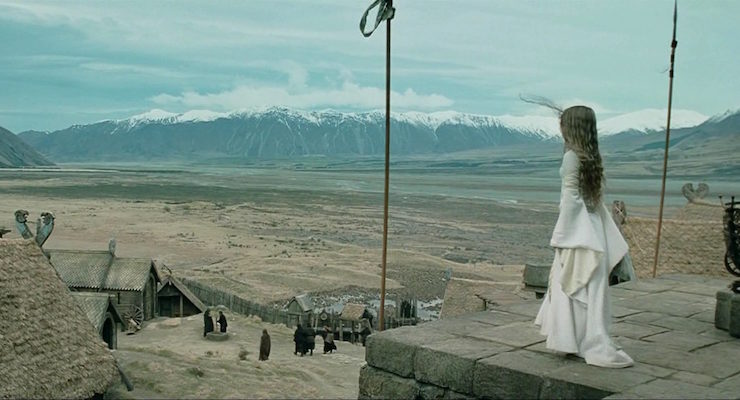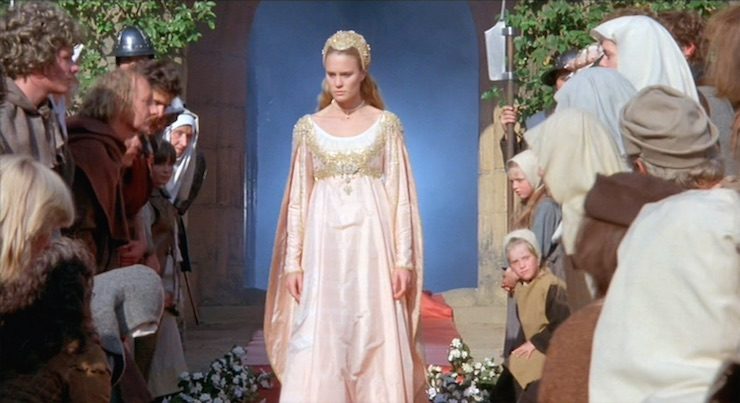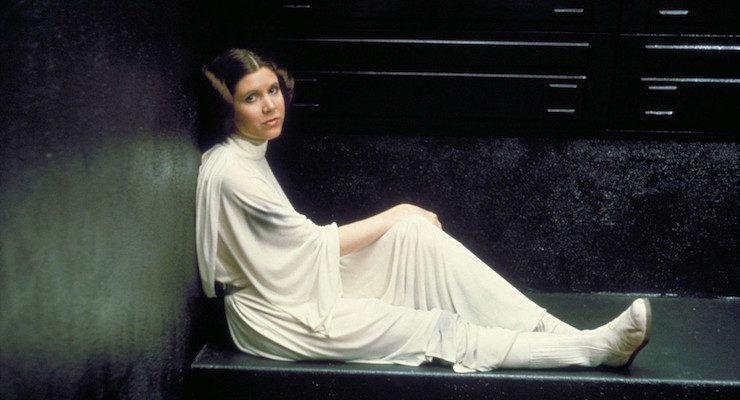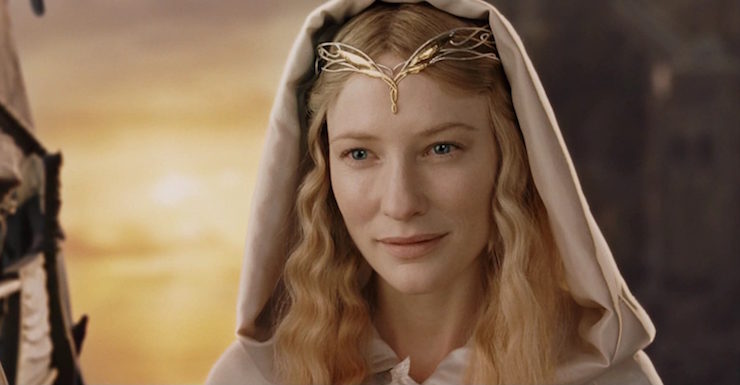You do not see the woman in white head-on.
Not at first. She is not looking at you. She is looking at something else, someone more important. She has a purpose. She has a vision. You are not worthy.
When she does look at you, she does not smile. You feel even less worthy, unworthy even to touch the hem of her robe. Or is it a cloak? Or a gown? It doesn’t matter. It’s too good for you.
She is too good for you.
In a blood-soaked world where survival is dependent upon grit and determination, the woman in white is spotless. She is radiant. She is pure.
The woman in white is often used as a main character’s motivation. She is his comfort in times of trouble, the source of his courage, and the object of his protection. His journey is one of attempting to become worthy of the woman in white and all she represents. His reward is her approval, her affection, her respect.
She is a thing worth dying for.

When a costumer selects a broad white expanse of cloth for a female character, they are making a statement about that character. She is pristine—an assigned value which means many things. She has never killed before. She is a virgin. She is wealthy, or at least well-kept. She is civilized. When a male protagonist sees the woman in white, he sees everything that, to a western colonialist narrative, is worth protecting: virtue, patience, stability, and purity. The woman in white reminds the hero of what he is fighting for. He is fighting for that white cloak—for its ability to remain unblemished, no matter what.
For her part, the woman in white must remain pure and radiant in order to continue motivating that hero. He will do whatever it takes to protect her and the things she stands for; thus, it is her solemn duty to remain unblemished. If she doesn’t (or so the logic goes)—if she lets him see a stain on her white gown—then the hero will stop fighting, and all will be lost.

Sometimes, the woman in white is used to reinforce an existing narrative. She is presented to a hero, and he is inspired, and he fights for her, and at the end of the day perhaps he is allowed to sleep curled at the foot of her bed.
Other times—and frequently in contemporary film and television—the woman in white is used to subvert that existing narrative. She is presented to a hero, and he is inspired, and he fights for her… and then she grabs a gun or a sword or a magical staff and fights for herself, because that hero isn’t doing the job well enough. This subversion is delightful to viewers who feel the societal constraints of being the woman in white, because it reminds them: you do not have to remain spotless and fearful while someone else fights for you. You can fight for yourself.
That said, the subversion of the woman in white is also frequently played to delight viewers who identify strongly with the male protagonists. After all, what is more delightful than seeing a woman pulled off of a pedestal?

There is no greater example of this narrative decay than in the character of Leia Organa. In the original Star Wars trilogy, Leia’s character shifts along with her costume. In A New Hope, she is clothed entirely in white. For the first half of the film, she serves as a motivating force in Luke’s journey—while she’s not afraid to take matters into her own hands, she is demonstrably aware of her status. Despite Luke and Han’s evident attraction to her, she is not available to either of them. Even at the end of the film, when she is acknowledging them as heroes, Leia is clad almost entirely in white.
But by then, they’ve earned her smile.

Throughout Empire Strikes Back, Leia shifts between being a woman in white and a more relatable, available character. The more emotion she shows—the more vulnerability she shows—she more color she wears. Her Hoth snowsuit is white, but dingy and damaged in places, and her boots are gray—and it’s this outfit that she wears while she’s arguing with Han, allowing him to treat her as an equal rather than a superior. Similarly, her russet Bespin gown is worn under an off-white cloak at cloud city, tipping off the viewer that she’s not as invulnerable as she might seem. At the end of the film, the only signal of her safety—and her renewed loneliness—is the return of her white gown.

By the time Leia Organa makes it to Return of the Jedi, her white garments are gone. She’s rebel scum now, through-and-through; she’s available to Han, comrades with Luke. She’s shot and lied and bluffed her way through a revolution. Her Boushh disguise—the clothes of a bounty hunter—are used as a shocking reveal for the viewer, who is used to thinking of her as a woman in white (or at least a woman in off-white). The disguise serves as a narrative reinforcement: it’s been a while since Cloud City, the viewer is reminded, and Leia is not the same person she was before. In a way, this softens her transition into the notorious bikini, making that transition more palatable to the audience. This is not a princess, we are reminded; this is not a woman in white. This is a rebel. Feel bad for her, but not too bad—she’s not what Luke is fighting for, not anymore. She’s on her own, and if she winds up in a bikini with a chain shackled to her throat, so be it.

After her escape from Jabba the Hutt, Leia is not returned to her former status as a woman in white. If she was, the viewer would not believe it—we have seen her fall from her pedestal. We have seen her in vulnerable, risky positions. We have seen her kill. She can no longer be a passive, celestial motivator for a male protagonist—instead, she has become a protagonist in her own right. She is allowed to smile at last, because her white chemise is dominated by her brown dress. And she must wear the brown dress, because she has been allowed to smile.

 Sarah Gailey’s fiction has appeared in Mothership Zeta and Fireside Fiction; her nonfiction has been published by Mashable and Fantasy Literature Magazine. You can see pictures of her puppy and get updates on her work by clicking here. She tweets @gaileyfrey. Watch for her debut novella, River of Teeth, from Tor.com in May of 2017.
Sarah Gailey’s fiction has appeared in Mothership Zeta and Fireside Fiction; her nonfiction has been published by Mashable and Fantasy Literature Magazine. You can see pictures of her puppy and get updates on her work by clicking here. She tweets @gaileyfrey. Watch for her debut novella, River of Teeth, from Tor.com in May of 2017.











I never stopped to think about it, but you’re quite right. As I was reading your article all I could think of was the childlike empress in The Neverending Story which is not even thinly veiled that it’s the “prize” at the end of the hero’s quest and quite blatantly “childlike” is spelled out. What do we make of non-women in white. Like White Dragons, or creatures? I’d love to read your thoughts on that. Great article!
Just wanted to say, I’m loving your writing in this series.
I’m suddenly reminded the Herald’s whites in Mercedes Lackey’s Valdemar books. Otherwise known as the “I’m here, shoot me now!” uniforms.
Even while wearing white, Leia shoots a stormtrooper within five seconds of showing up on screen for the first time. She’s subverting the trope from the begining.
Or they can be nurses.
I generally love your articles but I think this is a really odd reading of Leia’s character in ANH – Leia is a rebel from the second we meet her, white dress or no.
That said, I really hate the metal bikini – and yes, I know a lot of people have reclaimed that symbolism – especially since, as you do mention, the costuming IS done with a deliberate aim to ‘soften’ and ‘feminize’ her (because being a sex slave is so feminine!), according to various interviews. So I think there is something to the way she is costumed in Return of the Jedi in terms of the earth tones, etc, to seem more approachable, along with the Bespin gown in ESB.
But I don’t think we were ever supposed to take the ‘white dress’ trope on its face for Leia in ANH.
Buttercup is not really a woman in white. She only has some scenes in a white dress, and isn’t it mostly a wedding dress? Through most of the film, when the hero is literally pursuing her, she’s wearing red.
I also thought of the Neverending Story movie.
And I thought of Servalan.
Very good observations, as usual.
I am enjoying this series, but also hope at some point that it will cover men’s costuming as well. A lot of times in older movies, especially in adventure films, the guy in white was naïve, arrogant, or otherwise ignorant of local cultures, and would soon end up dead, while the hero would be dressed in tans and browns. With men, it seems to me that white has much less positive implications.
I do want mention that Galadriel is an odd exception to this trope too… People always forget that the War of the Rings is partly her fault and she is stuck in Middle earth as a punishment. I love Cate Blanchett’s portrayal in that she surprises herself when she doesn’t snatch the ring from Frodo’s hand and realizes that she has passed a test. Also she is scary in the best possible way; like Mary Poppins, she is a force of nature. She smiles a wonderful feral smile win her white dress. An old friend of mine just met Cate Blanchett in New York and i am jealous because I would have loved to have told her how much I lived how she circled the table and watched everyone’s reaction in the meeting with Gandalf, Elrond, and Saruman in the Hobbit.
Totally subverted, smashed to Hell and gone by C S Lewis, in The Lion, the Witch, and the Wardrobe, were the WItch Witch is the white-clad villain.
It’s treated ironically by H rider Haggard in She. Ayesha has killed, off-screen; she has killed Kallikrates, the only man she has ever desired. So we see her first in a dingy yellowing repurposed shroud. When she gets serious, and realizes that Leo Vincey is her Kallikrates reborn, she starts showing up in her white dress – though she has shown LH Holly herself in her white dress beforehand – she was only playing with him, or playing on him.
It’s also in her white dress that she re-enters the fire of life, and is burnt away as someone who’s lived too long.
@12 I’m also surprised that there was no mention of the White Witch, especially since it’s a major costume shift from her identity as Jadis, the Queen of Charn (in The Magician’s Nephew).
Galadriel might wear white; but she is as more a Wise Woman than a Maiden in terms of archetypes; considering that she’s over 7000 years old and a grandmother. She does serve to strengthen and motivate weary heroes, offer wise counsel to Gandalf and Elrond; and get her hands dirty by helping rescue Gandalf from Dol Guldur in “The Hobbit: Battle of the Five Armies”.
Also, Eowyn, who is pictured here standing alone in Edoras in her not so bright white gown, does not provide strong motivation to any of the heroes to fulfill their quests; she is more of an afterthought; which bothers her enough to motivate her to pursue a warrior’s death rather than stay and protect her people as regent and possible future queen. (though thankfully, she is saved from death)
Tolkien played with the “White Lady” trope: Galadriel is an old and powerful and very wise White Lady, Eowyn is a White Lady warrior-princess who eventually renounces war to become a healer. Aredhel, the White Lady of the Noldor, a fair-skinned white-gowned elven princess in The Silmarillion, is seduced by a dark (in terms of both garb and temperament) Elf and has an unhappy marriage and tragic fate. Of course, Tolkien’s favorite and most powerful heroine, Luthien, wears blue (also vampire-guise) and darker colors, not to mention a Silmaril.
@15 – thanks :) I kind of wanted to nitpick about Eowyn being included since she’s definitely no passive damsel in distress but I know that the screenshots are more about showcasing the costume than always about making a statement about the character itself. Although I agree that Galadriel also is a different version of this trope (although definitely does have that otherworldly, untouchable air, especially from the perspective of the heroes, and Gimli!)
The trope exists, but Jennifer@9’s Servalan is a nice counterexample!
But I wonder if the ‘purity’ aspect is overstated. Consider a man in white; an emperor, say (didn’t they actually use purple?) That says power and control – he doesn’t need to get his hands dirty with the minutiae of swatting dissidents etc. Can’t the same be true of an empress? (Though I’m not sure I get that vibe from Servalan, really – I think she just likes white.)
etranger@1: I don’t really know if monsters are colour-coded much in literature. In computer games, there’s a strong tendency towards ‘elemental’ coding, e.g. a white dragon will spit ice, whereas a red dragon will spit fire, and this useful game-mechanical hint probably drowns out any other options in most cases. Given the ubiquity of games nowadays, it probably leaks into other media.
@9 – is thought that as well. Although it can be argued she’s provides both Blake’s and Avon’s motivation.
@17 – colour-coding (dragons specifically, but is used elsewhere) comes from Dungeons and Dragons. A lot of the conventions for computer games originate there. Though it helps that the limits of early computers systems lent themselves to employing such tropes, literally codifying themselves into game design tradition.
A later example of colour-coded wardrobes come from table-top gaming as well. Warhammer’s Imperial colleges of magic devise themselves along the colour spectrum. So you know a wizard dressed in red will chuck fireballs. One dressed in blue will cast lightening bolts. Etc